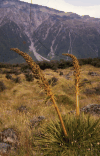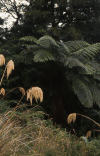In January/February 1988, after launching a gamma ray detector on a high altitude balloon from Antarctica I spent a couple of weeks visiting New Zealand. New Zealand is a member of the Commonwealth of Nations, and part of Oceania.
I rented a car in Christchurch and drove around the South Island. The car rental agency does not allow you to take the car to the North Island, but they let you drop off the car at the ferry to the North Island and then have a car ready for you at the ferry port on the North Island. This worked out very well.
From Christchurch I drove south through Dunedin, then across the Southern Alps to Milford Sound, a spectacular fjord on the west side of the South Island. From there I drove back over the Southern Alps and then north. At Mount Aspiring I crossed over to the west side again and drove north along the west coast. Along that road is Fox Glacier, a glacier that ends only about 10 km (6 miles) from the ocean. I followed the coast as long as there was a major road going north, then headed across the island to Picton to pick up the ferry to the North Island.
On the North Island I drove north, then west to Waitomo to see the glowworm caves. The glowworm cave is a spectacular sight. The ceiling of the cave looks like the night sky with myriads of stars, the stars being the glowworms, the larval stage of a small gnat. The glowworms hang on silk threads from the ceiling and glow to attract prey. These glowworms only live in New Zealand, and are well worth a visit.
From there I headed east again to Rotorua. The area around Rotorua is very volcanic, with hot springs and geysers. Rotorua itself smelled very strongly like sulfur from the volcanic activity.
From Rotorua I headed north to Auckland, and past there to Waitangi at the Bay of Islands. There I was lucky to see the huge war canoe. It is brought out annually during the celebration of the Treaty of Waitangi between the Maori and the Europeans. This war canoe is huge, it holds about 80 paddlers. It is an impressive sight, especially when the paddlers work in unison to loud chanting. It was a bit embarrassing for the war canoe that it got stuck in the mud, and the paddlers had to get out to free the canoe.
Back in Auckland I visited an animal park where the animals roam free, and the people are in cars. You better keep your windows closed, otherwise the lions may grab a snack ![]() .
.
People in New Zealand were very friendly everywhere. When I visited New Zealand in 1988, the population was not very large. One of the locals told me that the difference between England and New Zealand is that England has 30 million people and 3 million sheep, while New Zealand has 3 million people and 30 million sheep. Indeed, there were sheep everywhere in New Zealand.
New Zealand has left hand traffic. This causes sometimes serious problems with tourists at the many bridges. Many of the bridges were one lane wide. When tourists are on such a one-lane bridge and a car comes at them, they often instinctively pull right instead of left when coming off the bridge, right at the oncoming car. I was told by some locals that this causes lots of accidents. Otherwise traffic was quite disciplined, and (except around Auckland) not very heavy.
That was a problem! The food was original English food, bland, without taste, and without much variety. And the beer was warm English style ale, that tasted pretty sour, not at all to my liking. This is the only country in the world that I have visited so far where both food and beer was really awful. I would assume that by now this has changed, I can't see New Zealand keeping such a low standard of food and beer.
Altogether it was an interesting tour, the landscape, especially on the South Island is really spectacular, well worth a trip.
All pictures are © Dr. Günther Eichhorn, unless otherwise noted.




































































This page contains 68 pictures
Page last updated on Thu Mar 17 16:25:48 2022 (Mountain Standard Time)
New Zealand - Rugged Fjords, Hot Springs and Maori Traditions on mitsa.guenther-eichhorn.com